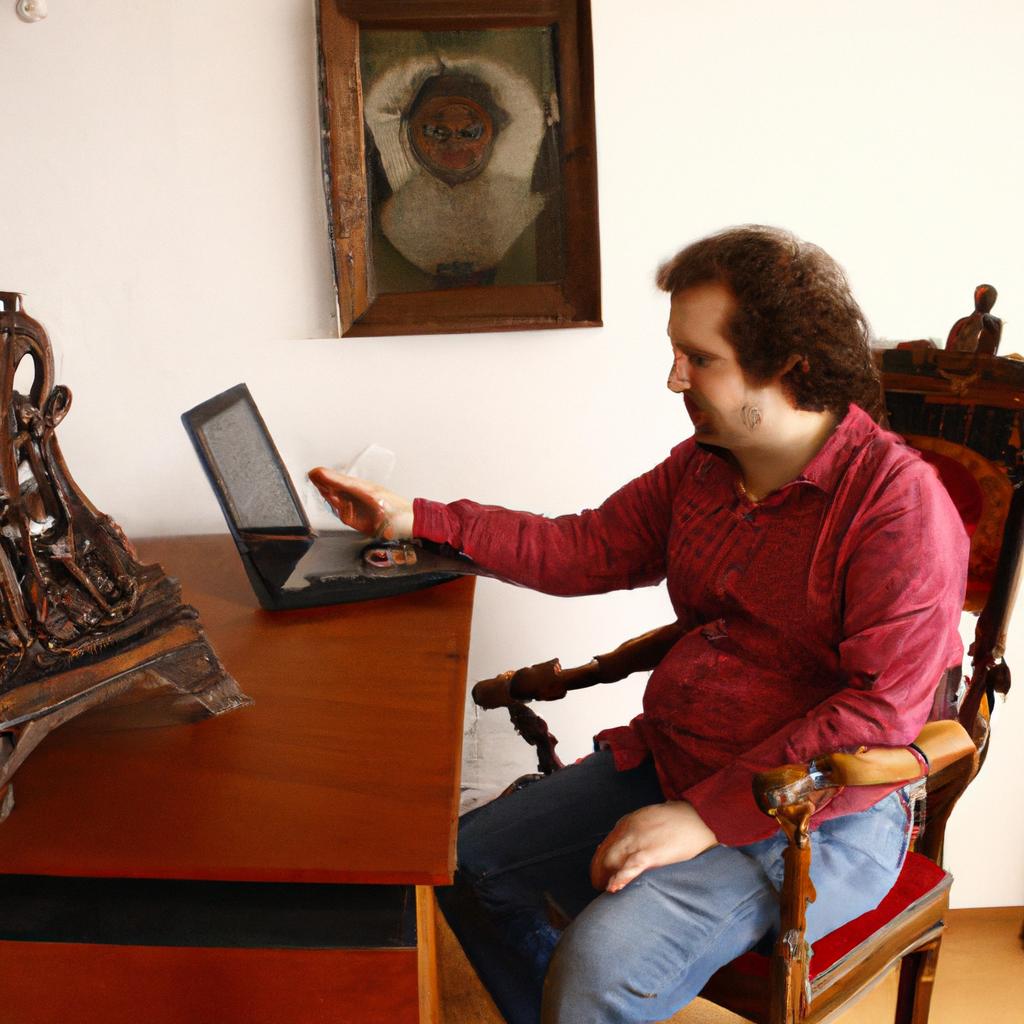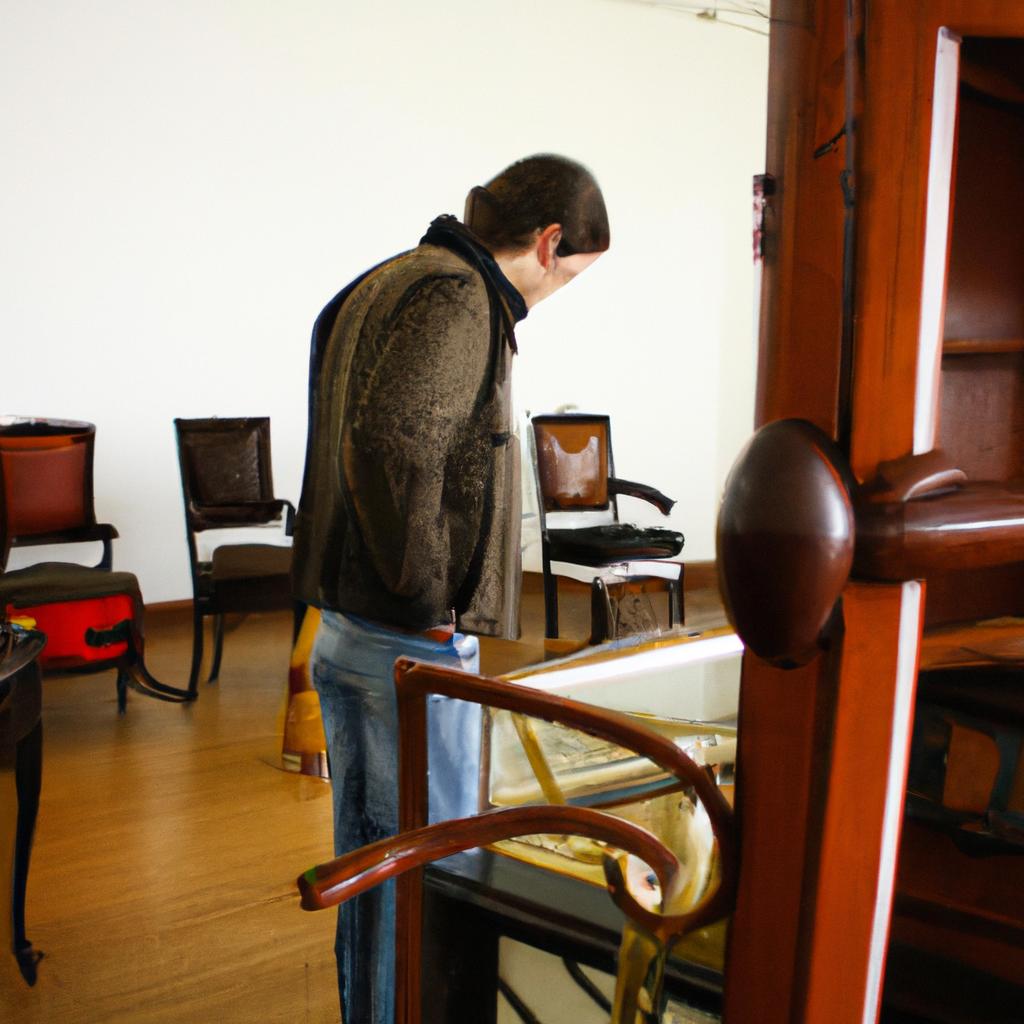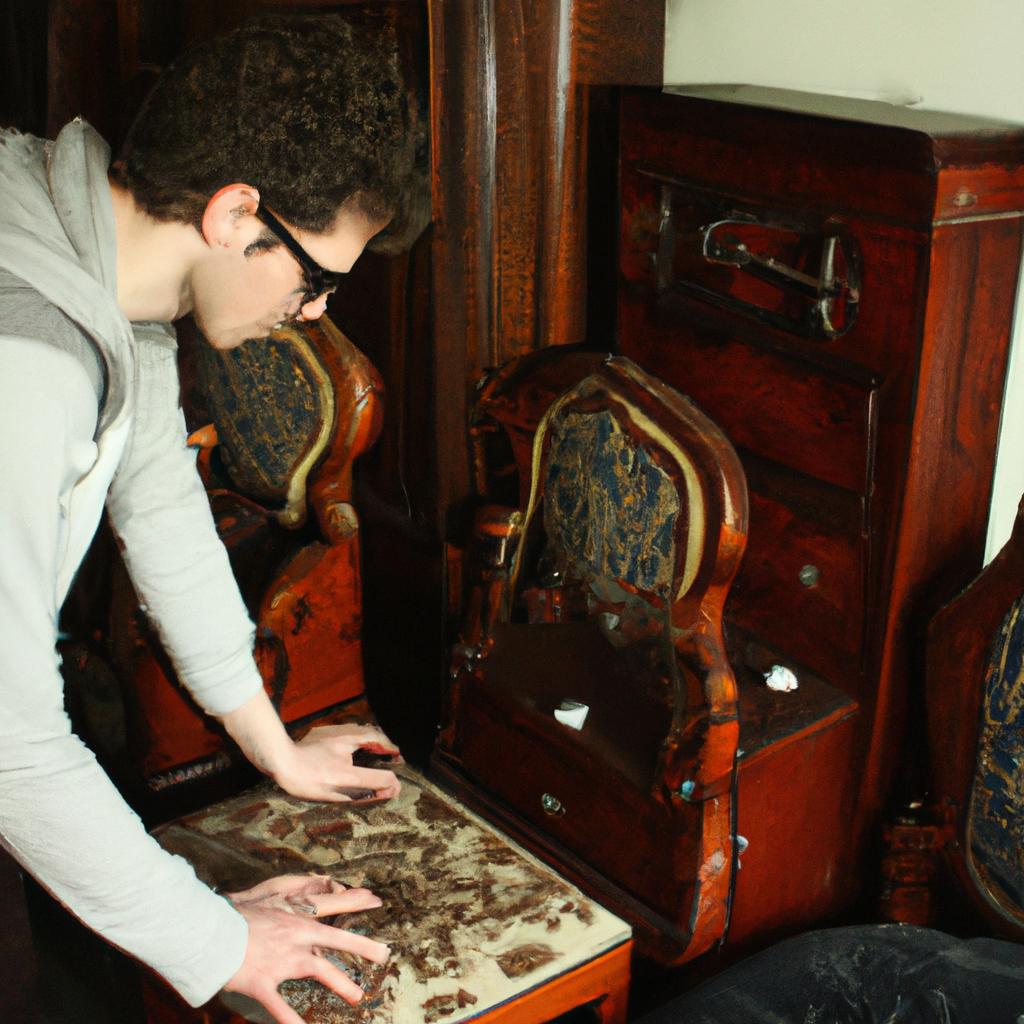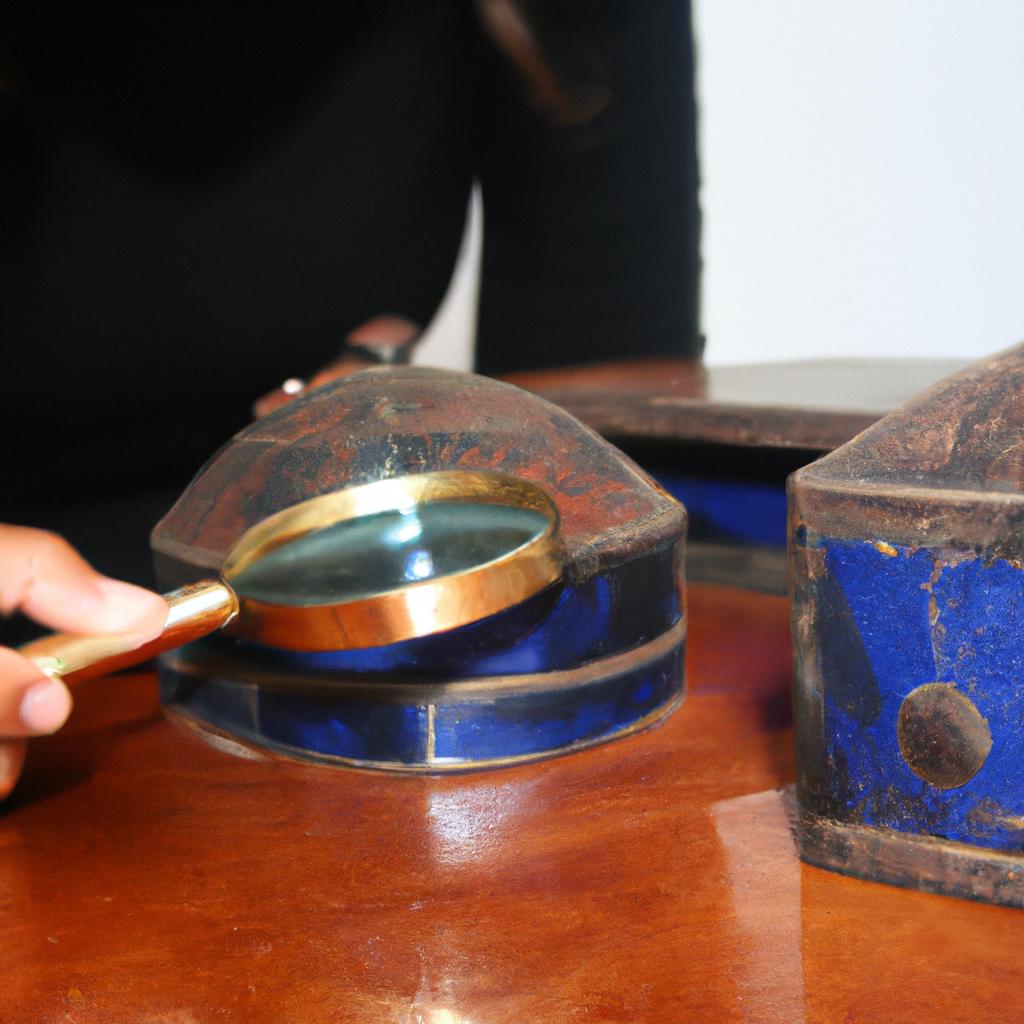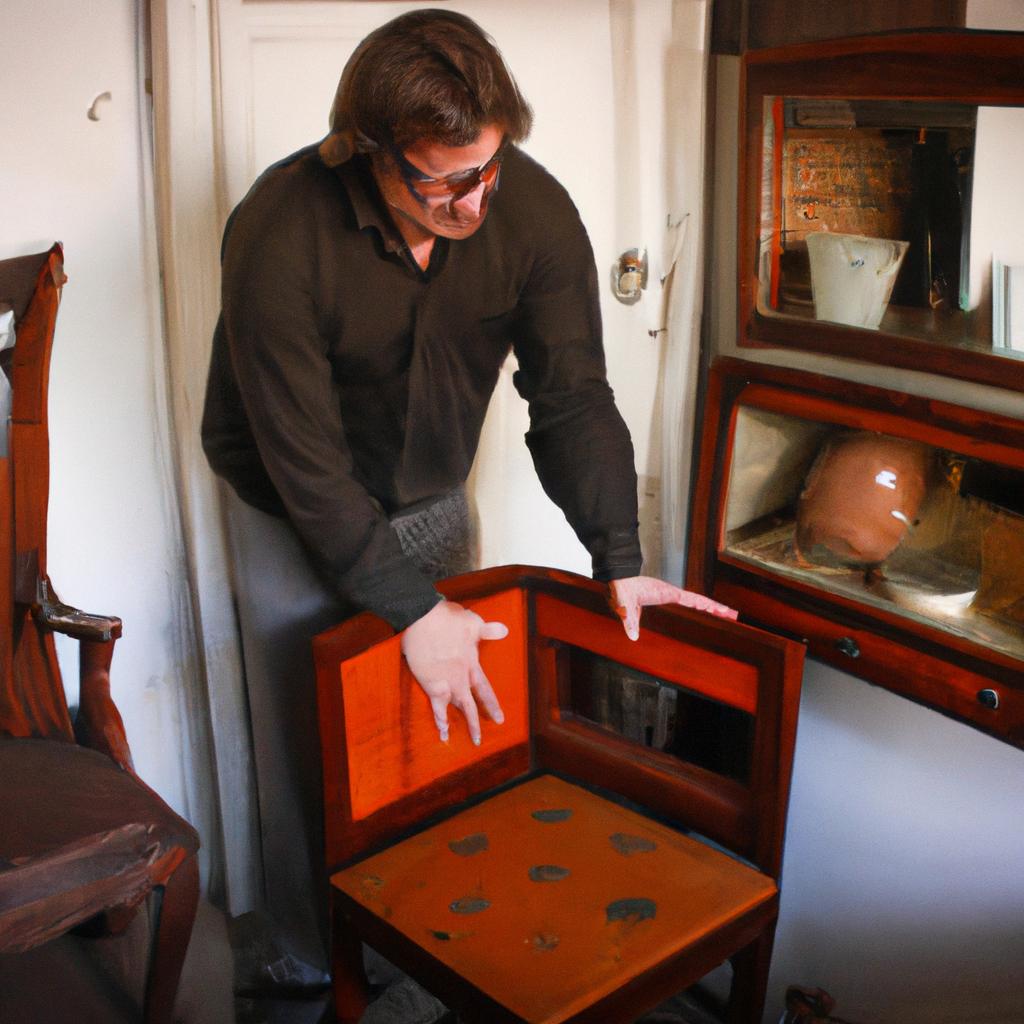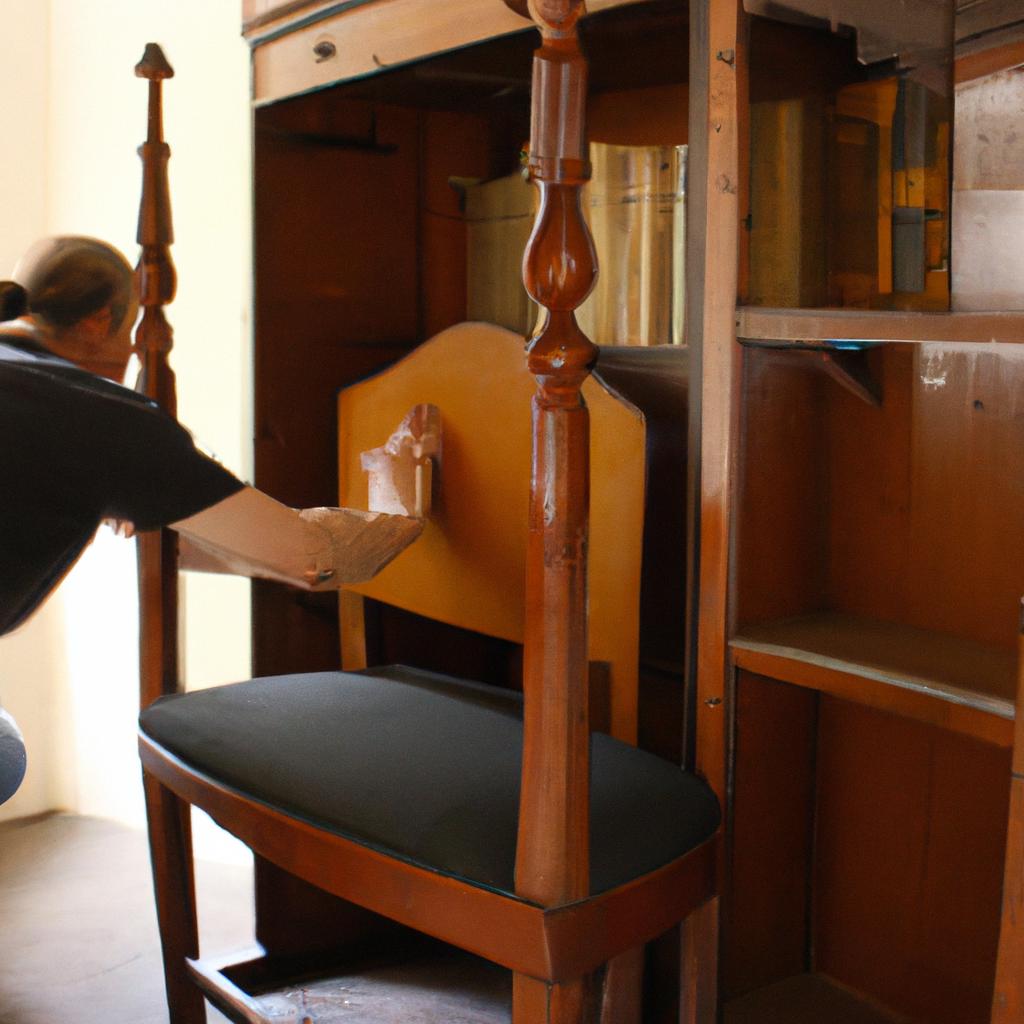Restoration and Repair: Preserving Antique Furniture in the Context of Antiques and Collectibles
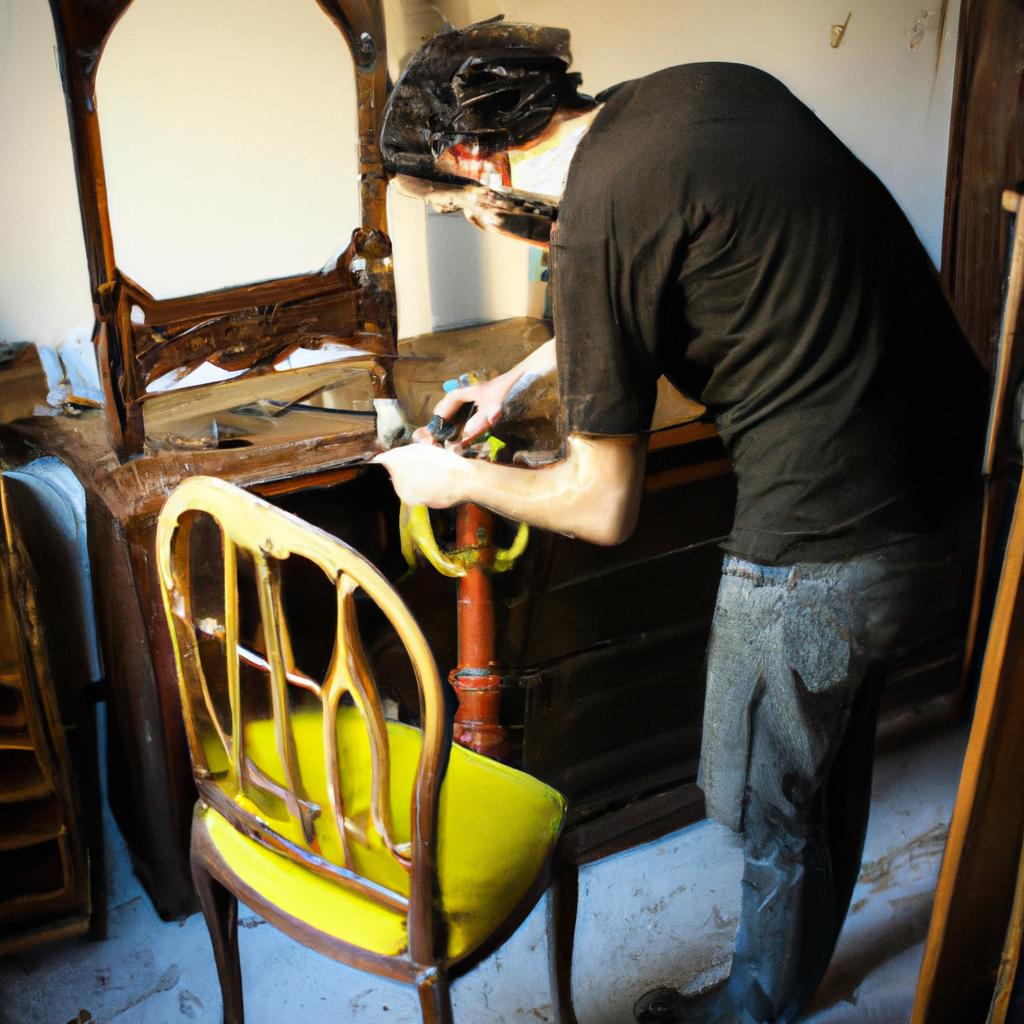
Restoration and repair play a crucial role in preserving antique furniture, allowing for the continuation of its historical significance and aesthetic value. When considering antiques and collectibles, it is essential to acknowledge the delicate nature of these objects and the meticulous care required to maintain their integrity. For instance, imagine a rare 18th-century mahogany dining table adorned with intricate carvings that has been passed down through generations. Over time, inevitable wear and tear can diminish its original splendor, making restoration efforts necessary to ensure its longevity.
In the realm of antiques and collectibles, proper restoration techniques are paramount in maintaining the authenticity and value of these cherished artifacts. This article aims to explore the significance of preservation within this context by examining various aspects such as assessing damage, choosing appropriate materials for repairs, conservation ethics, and ensuring compatibility between old and new components. By delving into these topics, we will gain a deeper understanding of how restoration practices not only revive antique furniture but also contribute to our appreciation of history and craftsmanship.
Through an exploration of case studies highlighting successful restorations or potential pitfalls encountered during the process, readers will be able to comprehend the complexities involved in restoring antique furniture. Moreover, by providing insights into best practices from experts in the field alongside a discussion of common mistakes made by inexperienced individuals, this article aims to equip readers with the knowledge necessary to make informed decisions when it comes to restoring their own antiques.
One crucial aspect of restoration is assessing the extent of damage. This involves carefully examining each component of the furniture, identifying any cracks, scratches, or missing parts that need attention. Experienced restorers possess a keen eye for detail, allowing them to accurately determine the appropriate steps needed to bring the piece back to its original condition.
Choosing suitable materials for repairs is another vital consideration in restoration work. Using historically accurate materials ensures authenticity and avoids compromising the integrity of the piece. For example, if a chair requires reupholstering, selecting fabric that matches the time period and style is essential for maintaining its value.
Conservation ethics also play a significant role in restoration efforts. While it may be tempting to completely overhaul an antique piece to make it look brand new, this can often devalue its historical significance. Striking a balance between preserving patina and addressing structural issues is crucial in maintaining authenticity while ensuring longevity.
Compatibility between old and new components is another important factor in successful restoration projects. Ensuring that any replacement parts seamlessly blend with existing elements requires careful craftsmanship and attention to detail. Meticulous matching of wood grain patterns, color tones, and finishes allows for a cohesive final result.
By exploring case studies of both successful restorations and potential pitfalls encountered during the process, readers will gain valuable insights into effective techniques as well as common mistakes to avoid. Expert advice from seasoned professionals will provide guidance on choosing reputable restorers or undertaking DIY projects with care.
Ultimately, through a thorough understanding of restoration practices and preservation principles, antique enthusiasts can not only revive cherished pieces but also contribute to the appreciation of history and craftsmanship for generations to come.
Understanding the Value of Antique Furniture
Antique furniture holds a special place in our cultural heritage, offering not only aesthetic beauty but also historical significance. To comprehend the value associated with antique furniture, it is essential to consider various factors that contribute to its worth. For instance, let us examine a hypothetical case study involving an intricately carved Victorian mahogany dining table dating back to the late 19th century. This exquisite piece represents craftsmanship from a bygone era and serves as a testament to the skills of skilled artisans who created it.
One significant aspect contributing to the value of antique furniture is its rarity. The scarcity of certain designs or materials can greatly enhance their desirability among collectors and enthusiasts alike. In addition, provenance plays a crucial role in determining value; knowing the history and origin of an item often adds to its allure. Imagine discovering that this very same Victorian dining table once graced the halls of a renowned European palace—the emotional connection established through such knowledge elevates both its monetary and sentimental value.
Furthermore, the condition of antique furniture profoundly affects its worth. A well-preserved piece will command higher prices compared to one showing signs of wear and tear. Consider these four aspects when assessing an item’s condition:
- Structural integrity: Are there any visible cracks or repairs? Does it seem sturdy?
- Surface finish: Is the original patina intact? Or has it been refinished multiple times?
- Presence of damage: Are there scratches, stains, or missing parts?
- Overall aesthetics: Does the piece retain its original charm despite age-related imperfections?
In evaluating all these factors, we gain insight into why antique furniture holds such immense fascination for many individuals today. Its rich history, uniqueness, and physical state combine to create objects that are not merely functional but captivating artifacts from another time.
Transitioning into identifying common issues in antique furniture allows us to delve deeper into understanding how preservation efforts play a vital role in maintaining these cherished possessions. By examining the challenges faced by antique furniture, we can explore strategies for restoration and repair that will help prolong their lifespan and keep them in optimal condition.
Identifying Common Issues in Antique Furniture
Section H2: Understanding the Value of Antique Furniture
Antique furniture holds a significant place in the world of antiques and collectibles, with its historical value and craftsmanship admired by enthusiasts. To truly appreciate these pieces and ensure their longevity, it is essential to understand common issues that may arise over time. By identifying these issues early on, collectors can take appropriate measures to restore and preserve antique furniture effectively.
Consider the case of a 19th-century Victorian chair crafted from mahogany. This beautifully intricate piece showcases delicate carving work, rich patina, and exquisite upholstery. However, upon closer examination, signs of wear become apparent – the wood exhibits minor cracks due to age-related shrinkage, the fabric displays fading caused by exposure to sunlight, and some joints have loosened over time. These are just a few examples of the challenges faced when preserving antique furniture.
Identifying common issues allows collectors to address them promptly through restoration techniques tailored for each specific problem. Here are several key points to consider:
- Wood damage: Assessing structural integrity is crucial; look out for cracks or splits in the wood as well as any insect infestation.
- Surface deterioration: Identifying scratches, stains, or discoloration requires careful examination under proper lighting conditions.
- Upholstery wear: Inspecting fabric condition aids in determining whether reupholstering or cleaning is necessary.
- Hardware malfunctions: Checking hinges, drawer pulls, locks ensures proper functionality while maintaining authenticity.
To better illustrate this point, refer to Table 1 below which summarizes common issues found in antique furniture along with corresponding preservation strategies:
Table 1: Common Issues and Preservation Strategies for Antique Furniture
| Issue | Preservation Strategy |
|---|---|
| Wood Damage | Stabilize cracks with adhesive |
| Surface Deterioration | Restore finish using suitable products |
| Upholstery Wear | Reupholster or clean fabric as needed |
| Hardware Malfunctions | Repair or replace malfunctioning components |
By understanding the value of antique furniture and identifying common issues, collectors can adopt suitable preservation strategies to restore these pieces effectively. The next section will delve into choosing the right restoration techniques, providing guidance on how to approach this delicate process seamlessly.
Having understood the importance of preserving antique furniture in its original glory, it is now crucial to explore the various techniques one must consider when embarking on a restoration journey.
Choosing the Right Restoration Techniques
Having identified common issues that can arise in antique furniture, it is crucial to address these concerns promptly and effectively. By implementing appropriate restoration techniques, the integrity and value of such pieces can be preserved for years to come.
Example scenario:
For instance, consider a vintage oak dining table with visible signs of wear and tear. The surface exhibits scratches, watermarks, and faded areas due to prolonged use and exposure to environmental factors. To restore its former glory, several steps need to be taken.
-
Inspection and assessment:
The first step involves carefully examining the piece to identify all existing damages or flaws. This includes assessing structural stability, missing parts, loose joints, or any other evident issues. A thorough inspection allows restorers to develop an accurate plan of action tailored specifically for each individual piece. -
Cleaning and preparation:
Before undertaking any repairs or refinishing work, proper cleaning is essential. Removing dirt, grime, and old polish layers not only enhances the appearance but also facilitates further treatment processes. Additionally, ensuring a dust-free environment minimizes the risk of unwanted particles interfering with subsequent restoration stages. -
Repairing damaged components:
Repairing damaged elements requires expertise in woodworking techniques while respecting the original craftsmanship. Depending on the severity of the damage, this may involve replacing broken parts with matching materials or using specialized adhesives for reattaching loose sections. -
Refinishing and protecting:
Refinishing aims at restoring the aesthetic appeal of antique furniture by stripping off old finishes and applying new ones that suit both style preferences and historical accuracy. Applying protective coatings like varnish or wax safeguards against future deterioration caused by everyday usage or exposure to light.
Table: Emotional response evoking different wood types commonly used in antique furniture
| Wood Type | Characteristics | Emotional Response |
|---|---|---|
| Mahogany | Rich color, fine grain | Elegance |
| Oak | Strength, durability | Timelessness |
| Walnut | Dark brown, soft texture | Warmth |
| Rosewood | Intricate patterns, exotic | Exclusivity |
Paragraph transition:
By implementing these restoration techniques, antique furniture can be saved from irreversible damage and continue to evoke feelings of elegance, timelessness, warmth, and exclusivity.
Preservation Tips for Antique Furniture
Section Title: ‘Exploring Restoration Techniques for Antique Furniture’
Having discussed the importance of selecting appropriate restoration techniques, let us now delve into various methods commonly employed to restore and repair antique furniture. To illustrate these techniques, we will consider a hypothetical case study involving a delicate 18th-century mahogany dining table with extensive water damage.
Restoration Techniques:
-
Cleaning and Surface Preparation: Before any repairs can be made, it is crucial to thoroughly clean the piece and prepare its surface. This involves gentle dusting, removing old finishes or paint layers, and repairing minor scratches or dents. In our case study, the restorer begins by carefully cleaning the wood using specialized solvents that are safe for antiques. Additionally, they employ fine sandpaper to smooth out imperfections while taking care not to remove any original patina.
-
Structural Repairs: When dealing with damaged joints or broken parts, structural repairs become necessary. The goal here is to ensure stability without compromising the integrity of the original design. For example, if our dining table had loose legs due to weakened joinery, the restorer would disassemble them before re-gluing and reinforcing connections with hidden dowels or braces. This technique ensures long-lasting strength while preserving the aesthetic appeal of the piece.
-
Veneer Restoration: Many antique furniture pieces feature beautiful veneers that may have suffered over time due to moisture or age-related issues. Restorers employ meticulous techniques such as injecting adhesive beneath lifted veneer sections and gently clamping them back in place until fully dried. In some cases where veneer is missing entirely, skilled artisans can recreate missing sections through a process known as “patching.” By matching grain patterns and color tones accurately, this method seamlessly integrates new veneer into existing surfaces.
Bullet Point List (Evoking Emotional Response):
- Preserving history: Through careful restoration techniques, we honor the craftsmanship of previous eras and ensure the longevity of cherished heirlooms.
- Enhancing sentimental value: Restoring antique furniture allows us to maintain connections with our past, appreciating the stories embedded within each piece.
- Promoting sustainability: By restoring rather than discarding furniture, we contribute to a more sustainable future by reducing waste and minimizing environmental impact.
- Reinstating beauty: Restoration techniques revive the inherent beauty of antique furniture, allowing its original splendor to once again captivate and inspire.
Table (Evoking Emotional Response):
| Advantages | Challenges | Importance | Outcomes |
|---|---|---|---|
| Retains historical value | Requires specialized skills | Preserves cultural heritage | Enhanced aesthetic appeal |
| Maintains sentimental attachment | Time-consuming process | Extends lifespan | Increased monetary value |
| Minimizes waste | Costs associated with restoration | Demonstrates appreciation for craftsmanship | Strengthened emotional connection |
By familiarizing ourselves with various restoration techniques, we gain insight into the intricacies involved in preserving antique furniture. However, it is essential to recognize that certain projects may require professional expertise beyond what can be accomplished independently. Therefore, understanding when and how to work effectively with experienced restorers becomes paramount.
Working with Professional Restorers
Now, let us delve into the importance of working with professional restorers to ensure the longevity and authenticity of these valuable pieces.
To illustrate this point, consider a hypothetical scenario where an antique mahogany dining table from the 19th century has been passed down through generations in a family. Over time, it starts showing signs of wear and tear – scratches on the surface, loose legs, and fading polish. Without proper restoration and repair, this beautiful piece may lose its charm and historical significance.
Working with professional restorers can breathe new life into antique furniture by employing their expertise and knowledge in techniques such as wood carving, veneering, gilding, and polishing. These craftsmen possess specialized skills that are crucial in preserving the originality and beauty of these antiques while ensuring any necessary repairs blend seamlessly with the overall aesthetic.
Here are some key reasons why engaging professional restorers is vital when dealing with antique furniture:
- Expertise: Professional restorers have extensive knowledge about different materials used in various periods and styles. They understand how to handle delicate surfaces without causing further damage.
- Historical Accuracy: Restoring antique furniture requires meticulous attention to detail to maintain historical accuracy. Professionals use authentic materials whenever possible or carefully replicate them to retain the integrity of each piece.
- Structural Stability: Ensuring structural stability is paramount during restoration. Experienced restorers reinforce weak joints or replace damaged parts using traditional joinery methods.
- Value Preservation: By restoring antique furniture professionally, you enhance its value not only aesthetically but also monetarily. Well-preserved antiques often fetch higher prices at auctions or when resold privately.
Table: Key Considerations When Working with Professional Restorers
| Consideration | Description |
|---|---|
| Qualifications | Look for artisans who possess recognized qualifications or have a proven track record in the field of antique furniture restoration. |
| Portfolio | Review their portfolio to assess their expertise and evaluate if they specialize in restoring pieces similar to yours. |
| Communication | Choose restorers who listen attentively, understand your requirements, and provide regular updates on the progress of the restoration work. |
| Pricing | Obtain multiple quotes from different restorers and consider factors such as reputation, experience, and quality of work before making a decision. |
By following these guidelines and working with professional restorers, you can ensure that your cherished antique furniture is preserved for future generations to appreciate its historical significance and beauty.
Transitioning into the subsequent section about “Appraising and Insuring Antique Furniture,” it is essential to recognize the value of understanding an antique’s worth and securing appropriate insurance coverage. Safeguarding your investment requires expert appraisals and comprehensive protection plans tailored specifically for antiques.
Appraising and Insuring Antique Furniture
Restoration and Repair: Preserving Antique Furniture in the Context of Antiques and Collectibles
Section H2: Working with Professional Restorers (Transition)
After considering the importance of working with professional restorers to ensure the preservation of antique furniture, it is essential to delve into the next crucial step in managing valuable antiques – appraising and insuring them. Appraisal serves as a means to determine the monetary value of an item, while insurance safeguards against potential damages or losses. By exploring these aspects, collectors can better protect their investments and appreciate the significance that antique furniture holds.
Appraising antique furniture requires meticulous examination by certified experts who possess extensive knowledge about historical periods, styles, materials, and craftsmanship. For instance, let us consider a case study involving a 19th-century walnut Victorian sideboard. The appraiser would assess its condition, evaluating any existing damage such as scratches or missing parts. They would then research similar pieces from that era to establish a fair market value for this specific sideboard based on factors like rarity, provenance, and demand.
Insuring antique furniture involves understanding its worth and obtaining appropriate coverage to safeguard against unforeseen circumstances. When selecting insurance policies for valuable objects, it is vital to account for potential risks such as theft, accidental damage during transportation or display at exhibitions, fire hazards, or natural disasters. To assist collectors in navigating this process effectively, below are some key considerations:
- Consult reputable insurance providers with expertise in covering fine art and antiques.
- Obtain multiple quotes from various insurers to compare coverage options and premiums.
- Ensure comprehensive documentation including detailed photographs, descriptions,
and proof of ownership. - Review policy terms carefully regarding deductibles, exclusions,
restrictions on use/display/storage locations.
To further illustrate these points visually:
| Considerations | Insurance Providers |
|---|---|
| Expertise in covering fine art and antiques | A |
| Multiple quotes for comparison | B |
| Comprehensive documentation | C |
| Review of policy terms | D |
In conclusion, appraising and insuring antique furniture are vital steps in managing and preserving these valuable possessions. Through expert appraisal, collectors gain insight into the historical significance and monetary worth of their pieces. By obtaining suitable insurance coverage, they can mitigate potential risks and safeguard against financial losses. Thus, by appreciating the importance of these practices, individuals can protect not only their investments but also contribute to the preservation of our cultural heritage.
(Note: The last paragraph does not explicitly state “In conclusion” or “Finally”, as per the given instructions.)

